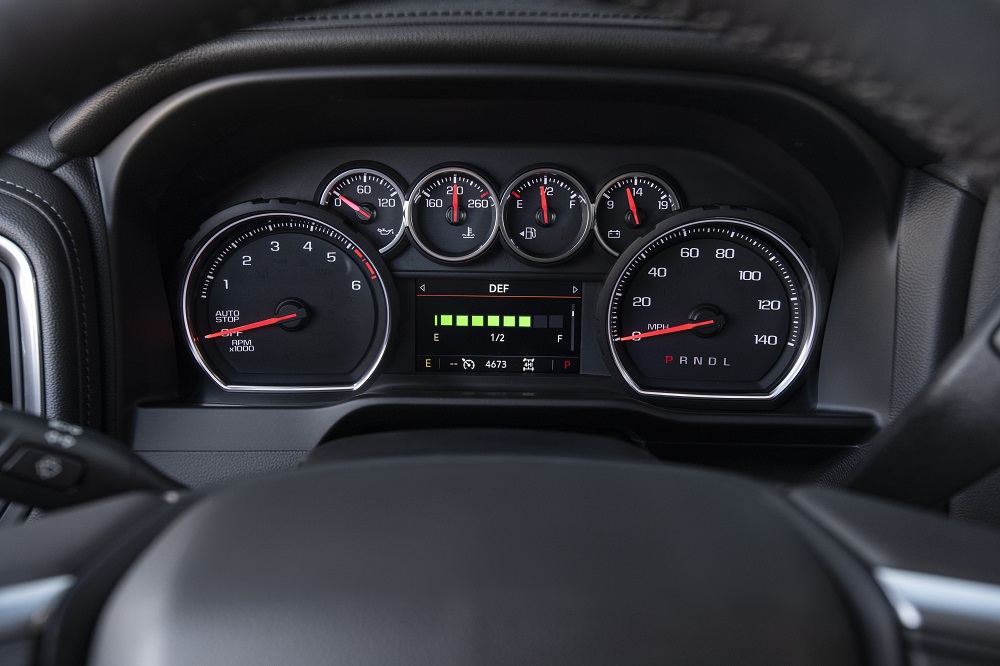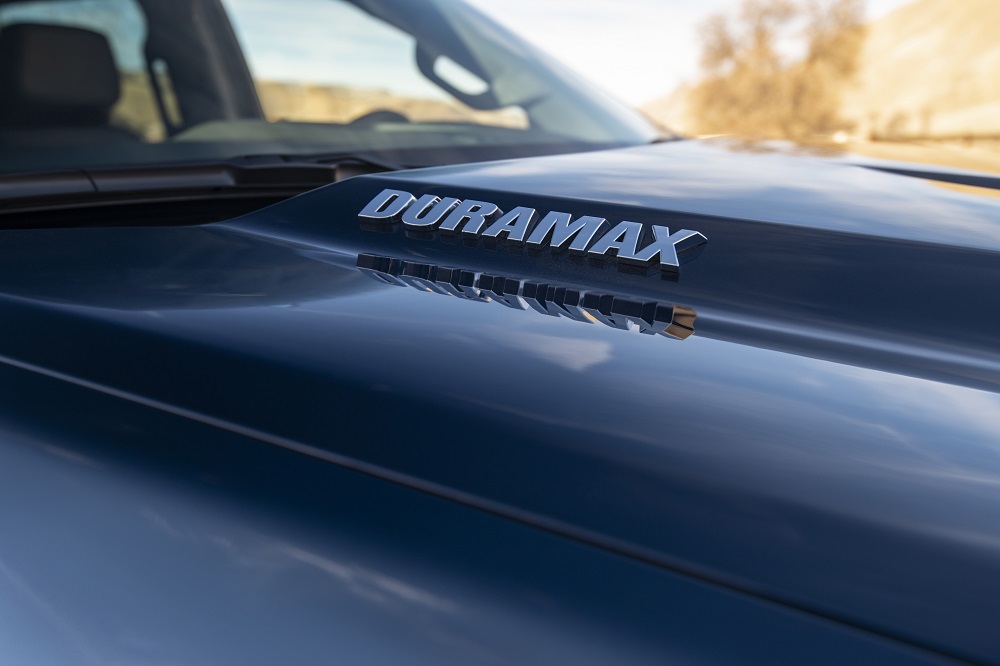Duramax Three-Liter Engine Coming to 2020 Silverado

For the first time in history, Chevy will offer an inline six-cylinder turbo-diesel Duramax option for various 2020 Silverado models.
Chevrolet has announced that the company will be offering an all-new DOHC inline six-cylinder turbo-diesel option for light duty 2020 Silverado models. As they say, big things come in small packages, and this engine is certainly no exception.
With an SAE-certified output of 277 horsepower and 460 lb-ft of torque, it beats both Dodge and Ford’s 3.0 Diesel V6 options. Impressively, peak torque is achieved at only 1,500 RPM and sustains until 3,000 RPM. Its additional power is not the only advantage. Choosing an inline layout allows for an inherently balanced and smooth running engine, creating a much more seamless and refined driving experience than expected with a diesel powerplant. Both the engine block and head are cast from aluminum, creating substantial weight savings as compared to iron block construction. The I6 is no weak target, however. It’s built with iron cylinder liners, a forged steel crankshaft, forged steel connecting rods and hypereutectic aluminum pistons, meaning they’re made from an aluminum alloy that exceeds aluminum’s usual melting point.

“From the moment the engine is started, to its idle, acceleration and highway cruising, the 3.0L Duramax performance will change perceptions of what a diesel engine can offer in refinement,” said Nicola Menarini, Chevy’s director for Diesel Truck Engine Program Execution. “With advanced technologies that draw on global diesel expertise, it’s a no-compromise choice for those who want the capability and driving range of a diesel in a light-duty truck.”
Lacking a couple of cylinders isn’t stopping this engine from diesel activities, either. The I6 uses GM’s 10-speed automatic transmission, and when it is in tow-haul mode, it allows for the use of exhaust braking just like its V8 big brother. A low-pressure EGR system recirculates some exhaust gasses into the intake, reducing combustion temperatures. With the electronically variable turbocharger and intake manifold, the engine works to deliver max torque as quickly as possible, giving the quick response required for towing and off-road applications.
Cold starting this little beast is a non-issue as well. It uses ceramic glow plugs that allow more rapid heating than traditional metal plugs, allowing unassisted cold startups as low as -22F (-30 C). Once running, temperatures still will not be a detriment thanks to its “Active Thermal Management,” a valve system that directs coolant through parts of the engine that need it most.
Overall, the six-cylinder Duramax engine is a great option to maintain the usability of your light-duty Silverado while enjoying the benefits of an efficient turbo-diesel engine. It will be available in 2020 Silverado LT, RST, LTZ, and High Country models.
Additional Technology Highlights

Variable geometry turbocharging enables the Duramax 3.0L engine to deliver class-leading horsepower with minimal effect on overall efficiency. The system uses closed loop controlled vanes position and sophisticated electronic controls to automatically adjust boost pressure to the desired value based on engine running conditions and instantaneous power demand. The liquid-cooled turbocharger features a low-friction ball-bearing shaft and is mounted close to the exhaust outlet of the engine for quicker spool-up of the turbine and quicker light-off of the exhaust catalyst. A water-to-air intercooling system produces a cooler higher density air charge for greater power. Maximum boost pressure is 43,5 psi (300 Kpa) absolute.
‘With advanced technologies that draw on global diesel expertise, it’s a no-compromise choice for those who want the capability and driving range of a diesel in a light-duty truck.’
Low-pressure EGR: The Duramax 3.0L utilizes new low-pressure Exhaust Gas Recirculation to optimize performance and efficiency. The EGR system diverts some of the engine-out exhaust gas and mixes it back into the fresh intake air stream, which is drawn into the cylinder head for combustion. That lowers combustion temperatures and rates.
Traditionally, EGR systems in diesel applications recirculate exhaust gases between the two high-pressure points, the exhaust manifold(s) and intake manifold. However, it generally requires efficiency-robbing assistance from the turbocharger or other supporting elements to achieve the pressure differential required for sufficient EGR flow rates.
The new low-pressure system adds to the high-pressure system, supporting continual adjustment of exhaust backpressure for more efficient operation. It recirculates gases between the low-pressure points in the exhaust system (downstream of the particulate filter) and after the compressor inlet.
When the low-pressure EGR is activated by an electronically controlled valve, the engine burns exhaust gas that has already passed through the particulate filter. That increases the turbocharger’s efficiency, which helps overall vehicle efficiency without deteriorating the rate of particulate matter emitted by the engine.

A variable intake manifold: offers dual air intake pathways for each cylinder. Electronically controlled flaps — one for each cylinder — shorten or lengthen the airflow to each cylinder. This optimizes the airflow into the engine and improves performance and responsiveness across the rpm band, particularly at lower engine speeds.
A variable-pressure oiling system with a continuously variable-displacement vane oil pump enhances efficiency by optimizing oil pressure as a function of engine speed and load. With it, the oil supply is matched to the engine requirements rather than the excessive supply of a conventional, fixed-displacement oil pump. The engine uses low-friction Diesel Dexos 0W20 oil.
Oil jets: Located in the block, the oil jets are employed for performance and temperature control. They target the inner core of the piston with an extra layer of cooling, friction-reducing oil. The jets reduce piston temperature, allowing the engine to produce more power and enhance long-term durability than engines without the technology.
Active Thermal Management: helps the engine warm up quickly to achieve and maintain its optimal engine temperature for performance and efficiency over the entire engine operating range. The system uses a three-actuator rotary valve system to distribute coolant through the engine in a targeted manner. It sends heat where it’s needed to warm up the engine to reduce friction and heat the passenger cabin or cools when needed for high-power operation. The Duramax 3.0L also features split cooling between the block and head.

Common rail direct fuel injection of 2,500 bar (36,250 psi): helps generates class-leading horsepower and torque. The system’s pressure is generated by an engine-driven twin-piston pump sending fuel to solenoid-activated injectors with nine-hole nozzles that support precise metering of the fuel for a smooth idle and lower combustion noise. The fuel system is capable of multiple injections per combustion cycle — up to 10 times per injector — for more consistent and stable combustion performance that translates into smoothness and refinement, particularly at idle.
Electronic throttle valve: The Duramax 3.0L features an electronic throttle valve to regulate intake manifold pressure in order to optimize exhaust gas recirculation rates. It also contributes to a smooth engine shutdown via a more controlled method of airflow reduction.
Ceramic glow plugs: used in the Duramax 3.0L heat up more quickly and hotter than conventional metal-based glow plugs, helping the engine start and heat up more quickly in cold weather. The Duramax 3.0L achieves unassisted and assisted starting temperatures of -22 F (-30 C) and -40 F (-40 C) respectively.
Stop/start technology: helps optimize efficiency in city driving. The driver-selectable system shuts off the engine at stoplights and other stop-and-go situations. The engine automatically restarts when the driver takes their foot off the brake.
Photos: Chevrolet

